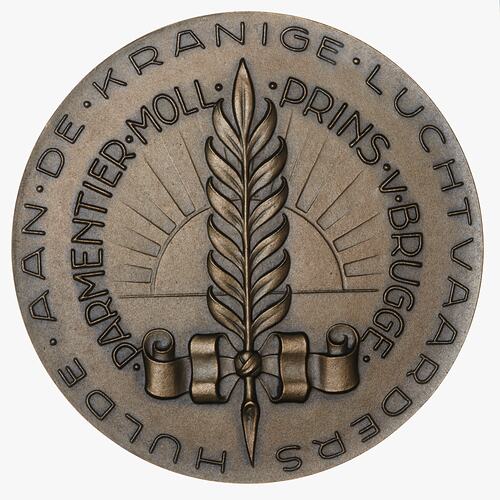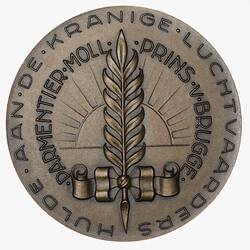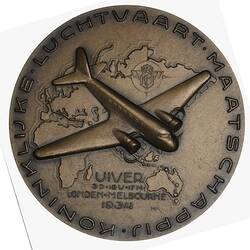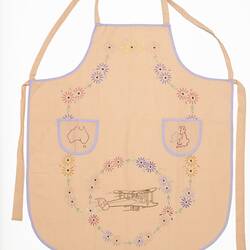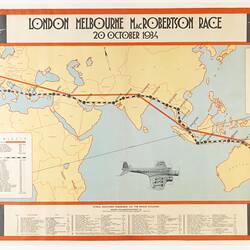Summary
Centenary International Air Race, 1934
Issuing Country: Netherlands
Mint: NV Koninklijke Nederlandsche Edelmetaal Bedrijven van Kempen, Begeer en Vos (Royal Dutch Precious Metal Companies van Kempen, Begeer and Vos)
Medal from the Centenary International Air Race of 1934. The medal commemorates K.D. Parmentier and J.J. Moll of the Netherlands, who flew a Douglas DC-2 passenger aircraft 'Uiver', of the Royal Dutch Airline KLM. Parmentier and Moll came second in the Handicap and Speed Races. KLM Royal Dutch Airlines was founded on 7 October 1919 by Albert Plesman. It is the oldest scheduled airline in the world with a continuous history, and has continued to operate under the same name to the present.
The Centenary International Air Race, from London to Melbourne, was sponsored by businessman and philanthropist Sir MacPherson Robertson, who had founded the largest confectionary business in the Commonwealth, MacRobertson Confectionary Manufacturers Ltd. The race route covered 18,240 km (11,330 miles) from England to Australia. All competitors were required to land at Baghdad, Allabad, Singapore, Darwin and Charleville. Prizes for the race included 10,000 pounds and a gold cup for the overall winner. English team C.W.A. Scott and T. Campbell Black were the eventual winners, flying through pylons at Flemington Racecourse in front of 40,000 spectators and landing at Laverton. Eight planes failed to finish the race. Gilman and Baines were tragically killed when their Fairy Fox crashed near Foggia, Italy.
The air race was instigated by the Lord Mayor of Melbourne, Sir Harold Gengoult-Smith, to mark the centenary of the foundation of Victoria. The Victorian Centenary Council supported his proposal. Gengoult-Smith approached philanthropist Sir Macpherson Robertson, who founded the largest confectionary business in the Commonwealth, MacRobertson Confectionary Manufacturers Ltd. Robertson had provided financial support for the Mawson Antarctic expedition, the MacRobertson Round Australian Expedition in 1928, the Herbarium, the Shrine fountain and the MacRobertson Girls' High School.
The race route covered 18,240 km (11,330 miles) from England to Australia. All competitors were required to land at Baghdad, Allabad, Singapore, Darwin and Charleville. There were few airfields on the route, the aircraft lacked navigational equipment and the only communication system available was Morse code. By 1930 only 12 planes had successfully completed the journey from England to Australia.
Prizes for the race included £10,000 and a gold cup for the overall winner. Handicap prizes were also offered. 63 planes were entered in the race, but their number was reduced by mechanical problems, lack of pilots and sponsorship difficulties.20 planes finally took off from Mildenhall airfield, near London, on 20 October 1934. Entrants hailed from Britain, USA, Australia, Holland, Denmark, New Zealand and New Guinea. Newspapers around the world called the race 'The Mildenhall Madness'. Public interest was immense, and large crowds gathered wherever the planes landed and took off.
When English team C.W.A. Scott and T. Campbell Black landed at Darwin airport on in their de Havilland DH 88 2 days, 4 hours and 38 minutes later, they had clipped 4.5 days off the existing record. Others were only hours behind. The KLM Douglas DC2 made a forced landing in a storm at Albury and, famously, hundreds of Albury residents lined the airfield with their headlights on to allow the plane to take off again. Scott and Black were the eventual winners, flying through pylons at Flemington Racecourse in front of 40,000 spectators and landing at Laverton. They also won the handicap prize. Their total flying time was 2 days, 22 hours and 34 minutes.
The race was symbolically important to Australia since it demonstrated to the world that Australia was only days away. It raised public spirits in the post-depression years and made Macrobertson a household name around the world. Above all, it focussed world attention on Melbourne at the time of its centenary.
Obverse Description
Aircraft with map showing route of air race in background. KLM logo above left wing. Inscribed beneath aircraft: UIVER / 3D . 18 U . 17M. /LONDON-MELBOURNE / 1934. [3D . 18U . 17 M = 3 days, 18 hours, 17 minutes, the time of the flight from London to Melbourne] Around: KONINKLIJKE . LUCHTVAART . MAATSCHAPPIJ [KLM = Royal Air Travel Company]
Reverse Description
Quill (?) tied with ribbon, rising sun in background. Around sun, PARMENTIER . MOLL. PRINS. V. BRUGGE. Around, HULDE . AAN . DE. KRANIGE . LUCHTVAARDERS [Homage to the courageous aviators]
Edge Description
Plain
More Information
-
Collection Names
-
Collecting Areas
-
Acquisition Information
Purchase from Spink Noble
-
Date Issued
1934 AD
-
Issued By
-
Person Commemorated
-
Person Commemorated
-
Organisation Named
-
Sponsor
Sir MacPherson Robertson - MacRobertson Pty. Ltd., Melbourne, Greater Melbourne, Victoria, Australia, 1934
-
Classification
-
Category
-
Discipline
-
Type of item
-
Dimensions
49 mm (Outside Diameter), 47.03 g (Weight)
-
Shape
Round
-
References
Jewell, Raymond N. 1988. The MacRobertson (Victorian) Centenary Air Race. NMAA Journal. 4 (March): 3-11. Cavill, Kenneth. 2000. The MacRobertson International Air Races of 1934 : a Centenary Celebration and a Forgotten Trophy. Australian Antique Collector. June-December 2000: 72-75.
[Article] Jewell, Ray T. 1988. The MacRobertson (Victorian) Centenary Air Race. Journal of the Numismatic Association of Australia. 4 (March): 3-11., No.4, March 1988, pp.3-11 Pages
[Article] Cavill, Kenneth. 2000. The MacRobertson International Air Races of 1934 : a Centenary Celebration and a Forgotten Trophy. Australian Antique Collector. (June-December 2000), Jun-Dec 2000, pp.72-75 Pages
-
Keywords
Air Races, Aircraft, Aviation, Celebrations, Centennial Air Race, London to Melbourne, 1934, Melbourne Centenary, 1935, Victoria Centenary, 1934-1935
